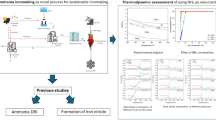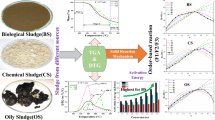Abstract
The thermokinetic parameters were investigated for cumene hydroperoxide (CHP), di-tert-butyl peroxide (DTBP), and tert-butyl peroxybenzoate (TBPB) by non-isothermal kinetic model and isothermal kinetic model by differential scanning calorimetry (DSC) and thermal activity monitor III (TAM III), respectively. The objective was to investigate the activation energy (E a) of CHP, DTBP, and TBPB applied non-isothermal well-known kinetic equation to evaluate the thermokinetic parameters by DSC. We employed TAM III to assess the thermokinetic parameters of three liquid organic peroxides, obtained thermal runaway data, and then used the Arrhenius plot to obtain the E a of liquid organic peroxides at various isothermal temperatures. In contrast, the results of non-isothermal kinetic algorithm and isothermal kinetic algorithm were acquired from a highly accurate procedure for receiving information on thermal decomposition characteristics and reaction hazard.












Similar content being viewed by others
Abbreviations
- A :
-
Pre-exponential factor (s−1)
- C A :
-
Sample concentration (mol L−1)
- C p :
-
Heat capacity (J g−1 K−1)
- E a :
-
Activation energy (kJ mol−1)
- f(α) :
-
Kinetic functions
- k :
-
Reaction rate constant (min−1)
- k i :
-
Reaction rate constant at isothermal temperature (min−1, i = 0, 1, 2, 3)
- k iso :
-
Rate constant at isothermal temperature (min−1, ISO = 80, 90, 100, 110, 120)
- M :
-
Molecular weight (g mol−1)
- m :
-
Sample mass (g)
- n :
-
Reaction order (dimensionless)
- Q :
-
Heat of decomposition at time t (W g−1)
- Q 0 :
-
Total heat of decomposition (kJ kg−1)
- Q t :
-
Decomposition heat released at time t (kJ kg−1)
- R :
-
Gas constant (8.31415 J K−1 mol−1)
- r :
-
Reaction rate (g s−1)
- T 0 :
-
Exothermic onset temperature (°C)
- T f :
-
Final temperature (°C)
- T i :
-
Peak temperature of different scanning rates (°C, i = P1, P2, P3)
- T j :
-
Different isothermal temperatures (°C, j = 0, 1, 2, 3)
- TCL :
-
Time to conversion limit (day)
- TMR iso :
-
Time to maximum rate under isothermal conditions (min)
- T P :
-
Peak temperature (°C)
- t :
-
Time (s)
- α :
-
Conversion rate (dimensionless)
- β i :
-
Scanning rate (°C min−1, i = 1, 2, 4, 10)
References
Huang D, Han M, Wang J, ** Y. Catalytic decomposition process of cumene hydroperoxide using sulfonic resins as catalyst. Chem Eng J. 2002;88:215–23.
Hou HY, Shu CM, Tasi TL. Reactions of cumene hydroperoxide mixed with sodium hydroxide. J Hazard Mater. 2008;152:1214–9.
Lin DU, Xu YF, MaoFa GE, Jia L, Yao L. Experimental investigation of incremental reactivity of di-tert-butyl peroxide. Chin Sci Bull. 2007;52(12):1629–34.
Brandrup EJ, Immergut EH, Grulke EA. Polymer handbook, 4th ed. II/2-69; Aldrich Catalog No. Z41, John Wiley, New York, USA;1999. p. 247.
Lu Y, Ng D, Miao L, Mannan SM. Key observations of cumene hydroperoxide concentration on runaway reaction parameters. Thermochim Acta. 2010;501:65–71.
Material safety data sheet, Amersfoort, The Netherlands;2007.
Code for the storage of organic peroxide formulations, NFPA 432, National Fire Protection Association (NFPA), Quincy, MA, USA;2008.
STARe software with solaris operating system, operating instructions; Mettler Toledo, Sweden. 2004.
Ozawa T. A new method of analyzing thermogravimetric data. Bull Chem Soc. 1965;38:1881–6.
Flynn JH, Wall LA. Res Natl Bur Standards, Phys Chem. 1966;70:487–92.
Flynn JH, Wall LA. A quick, direct method for the determination of activation energy from thermogravimetric data. J Polym Sci. 1966;4:323–8.
Product Information, 2008, TAM III Thermostat. Available at: www.thermometric.com.
Cheng SY, Tseng JM, Lin SY, Gupta JP, Shu CM. Runaway reaction on tert-butyl peroxybenzoate by DSC tests. J Therm Anal Calorim. 2008;93:121–6.
Wu SH, Tsai TL, Hou HY, Tseng JM, Shu CM. 2006 Japan/Taiwan/Korea Chemical Engineering Conference, Japan 2006.
Chen CC, Shu CM, Yeh CA, Chen SC, Shu ML. The 17th Annual Conference of Asia Pacific occupational safety and health organization, Taipei, Taiwan, ROC 2001;295.
Ferguson HD, Towsend DI, Hofelich TC, Russel PM. Reactive chemicals hazard evaluation: Impact of thermal characteristics of transportation/storage vessels. J Hazard Mater. 1994;37:285–302.
Chen JR, Wu SH, Lin SY, Hou HY, Shu CM. Utilization of microcalorimetry for an assessment of the potential for a runaway decomposition of cumene hydroperoxide at low temperatures. J Therm Anal Calorim. 2008;93:127–33.
Lee RP, Hou HY, Tseng JM, Chang MK, Shu CM. Reactive incompatibility of DTBP mixed with two acid solutions. J Therm Anal Calorim. 2008;93:269–74.
The isothermal calorimetric manual for thermometric AB. Jarfalla, Sweden. 2007.
Hou HY, Shu CM, Duh YS. Exothermic decomposition of cumene hydroperoxide at low temperature conditions. AIChE J. 2001;47:1893–6.
You ML, Tseng JM, Liu MY, Shu CM. Runaway reaction of lauroyl peroxide with nitric acid by DSC. J Therm Anal Calorim. 2010;102:535–9.
Tseng JM, Liu MY, Chen SL, Hwang WT, Gupta JP, Shu CM. Runaway effects of nitric acid on methyl ethyl ketone peroxide by TAM III test. J Therm Anal Calorim. 2009;96:789–93.
Li XR, Koseki H. Thermal decomposition kinetic of liquid organic peroxides. J Loss Prev Process Ind. 2005;18:460–4.
Lin CP, Tseng JM, Chang YM, Liu SH, Cheng YC, Shu CM. Modeling liquid thermal explosion reactor containing tert-butyl peroxybenzoate. J Therm Anal Calorim. 2010;102:587–95.
Acknowledgements
The authors are indebted to the donors of the National Science Council (NSC) in Taiwan under the contract number NSC-96-2625-Z-224-001 for financial support.
Author information
Authors and Affiliations
Corresponding author
Rights and permissions
About this article
Cite this article
Liu, SH., Lin, CP. & Shu, CM. Thermokinetic parameters and thermal hazard evaluation for three organic peroxides by DSC and TAM III. J Therm Anal Calorim 106, 165–172 (2011). https://doi.org/10.1007/s10973-011-1582-x
Published:
Issue Date:
DOI: https://doi.org/10.1007/s10973-011-1582-x




